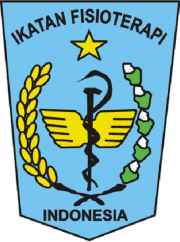Scapula Mobilization For Improving Functional Ability In Frozen Shoulder Conditions: Case Study
Fitria Maharani Nugraha(1), Arif Pristianto(2*), Ricky Fauzi Zakaria(3)(1) Universitas Muhammadiyah Surakarta
(2) Universitas Muhammadiyah Surakarta
(3) Rumah Sakit Condong Catur Yogyakarta
(*) Corresponding Author
Abstract
Background: Frozen Shoulder is characterized by progressive pain resulting in stiffness and limited active and passive motion in the shoulder joint. The primary or idiopathic cause of frozen shoulder is not known with certainty, while secondary causes are usually due to trauma, thyroid disease, and rheumatoid arthritis.
Objective: This study aims to determine the effect of scapula mobilization to improve functional ability in frozen shoulder conditions.
Method: This study used the case study method which was conducted on frozen shoulder patients at Condong Catur Hospital Yogyakarta in November 2022. Shoulder Pain and Disability Index (SPADI) to measure functional ability. SPADI is a quality of life questionnaire consisting of 13 items to evaluate 5 items for pain and 8 items for disability.
Results: After 3 times of physiotherapy, the results showed reduced pain, increased muscle strength, increased ROM, and increased functional ability.
Conclusion: Scapula mobilization is effective in reducing pain, increasing muscle strength, and increasing ROM so that there is also an increase in functional ability.Full Text:
PDFReferences
Atisook, R., Euasobhon, P., Saengsanon, A., & Jensen, M. P. (2021). Validity and utility of four pain intensity measures for use in international research. Journal of Pain Research, 14, 1129–1139. https://doi.org/10.2147/JPR.S303305
Cavalleri, E., Servadio, A., Berardi, A., Tofani, M., & Galeoto, G. (2020). The effectiveness of physiotherapy in idiopathic or primary frozen shoulder: A systematic review and meta-analysis. Muscles, Ligaments and Tendons Journal, 10(1), 24–39. https://doi.org/10.32098/mltj.01.2020.04
Date, A., & Rahman, L. (2020). Frozen shoulder: Overview of clinical presentation and review of the current evidence base for management strategies. Future Science OA, 6(10). https://doi.org/10.2144/fsoa-2020-0145
Duzgun, I., Turgut, E., Eraslan, L., Elbasan, B., Oskay, D., & Atay, O. A. (2019). Which method for frozen shoulder mobilization: Manual posterior capsule stretching or scapular mobilization? Journal of Musculoskeletal Neuronal Interactions, 19(3), 311–316.
Fernandes, M. R. (2015). Correlation between functional disability and quality of life in patients with adhesive capsulitis. Acta Ortopedica Brasileira, 23(2), 81–84. https://doi.org/10.1590/1413-78522015230200791
Ghorbanpour, A. (2019). Fascial Treatment in Frozen Shoulder: A Case Report. Journal of Modern Rehabilitation, 13(2), 123–128. https://doi.org/10.32598/jmr.13.2.123
Kisner, C., & Colby, L. A. (2012). Therapeutic Exercise Foundation and Techniques, Sixth Edition. In Philadelphia. F. A. Davis Company. https://doi.org/10.1123/att.7.2.40
Kraal, T., Beimers, L., The, B., Sierevelt, I., van den Bekerom, M., & Eygendaal, D. (2019). Manipulation under anaesthesia for frozen shoulders: Outdated technique or well-established quick fix? EFORT Open Reviews, 4(3), 98–109. https://doi.org/10.1302/2058-5241.4.180044
Membrilla-Mesa, M. D., Cuesta-Vargas, A. I., Pozuelo-Calvo, R., Tejero-Fernández, V., Martín-Martín, L., & Arroyo-Morales, M. (2015). Shoulder pain and disability index: Cross cultural validation and evaluation of psychometric properties of the Spanish version. Health and Quality of Life Outcomes, 13(1), 1–6. https://doi.org/10.1186/s12955-015-0397-z
Pandey, V., & Madi, S. (2021). Clinical Guidelines in the Management of Frozen Shoulder: An Update! Indian Journal of Orthopaedics, 55(2), 299–309. https://doi.org/10.1007/s43465-021-00351-3
Pragassame, S. A., Kurup, V. M., & Kifayathunnisa, A. (2019). Effectiveness of Scapular Mobilisation in the Management of Patients with Frozen Shoulder- A Randomised Control Trial. Journal of Clinical and Diagnostic Research, 5–9. https://doi.org/10.7860/jcdr/2019/41378.13045
Pratitdya, G., Rehatta, N. M., & Susila, D. (2020). PERBANDINGAN INTERPRETASI SKALA NYERI ANTARA NRS-VAS-WBFS OLEH PASIEN PASCA OPERASI ELEKTIF ORTHOPEDI DI RSUD Dr. SOETOMO. Care : Jurnal Ilmiah Ilmu Kesehatan, 8(3), 447. https://doi.org/10.33366/jc.v8i3.1802
Ramirez, J. (2019). Adhesive capsulitis: Diagnosis and management. American Family Physician, 99(5), 297–300.
Rangan, A., Brealey, S. D., Keding, A., Corbacho, B., Northgraves, M., Kottam, L., Goodchild, L., Srikesavan, C., Rex, S., Charalambous, C. P., Hanchard, N., Armstrong, A., Brooksbank, A., Carr, A., Cooper, C., Dias, J. J., Donnelly, I., Hewitt, C., Lamb, S. E., … Torgerson, D. (2020). Management of adults with primary frozen shoulder in secondary care ( UK FROST ): a multicentre , pragmatic , three-arm , superiority randomised clinical trial. Lancet (London, England), 396, 977–989. https://doi.org/10.1016/S0140-6736(20)31965-6
Santia, I., Fatimah, N., & Suciati, T. (2019). The Correlation Between Limited Range of Movement And Functional Ability of Frozen Shoulder Patient at Medical Rehabilitation Department RSUPDr Mohammad Hoesin Palembang. Majalah Kedokteran Sriwijaya, 51(1), 47–52.
Sarasua, S. M., Floyd, S., Bridges, W. C., & Pill, S. G. (2021). The epidemiology and etiology of adhesive capsulitis in the U.S. Medicare population. BMC Musculoskeletal Disorders, 22(1), 1–12. https://doi.org/10.1186/s12891-021-04704-9
Setiawan, D., & Pristianto, A. (2021). Program Fisioterapi pada Kondisi Drop Foot Pasca Total Hip Arthroplasty: A Case Report. Physiotherapy, 1, 1–6.
Article Metrics
Abstract view(s): 541 time(s)PDF: 298 time(s)
Refbacks
- There are currently no refbacks.







